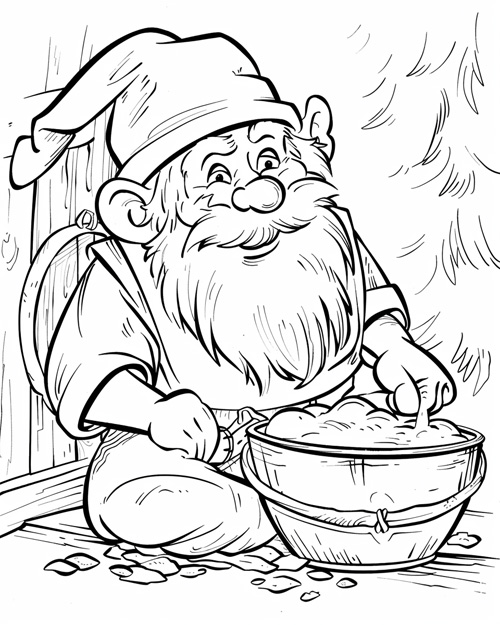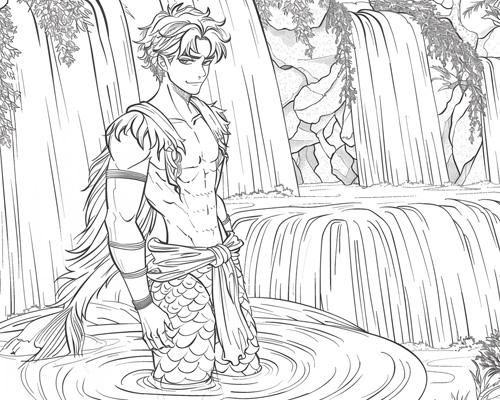Leanne's Printable Coloring Pages for Kids
Danish Mythology and Folklore Coloring Pages
Welcome to our Danish Mythology and Folklore coloring pages section.
Danish mythology and folklore are rich with fascinating tales and legendary figures that have been passed down through generations. From the powerful gods and heroes of Norse mythology to the enchanting spirits and creatures of local folklore, these stories reflect Denmark's deep cultural heritage. Explore the world of mythical beings like the Nisse, a mischievous household spirit, and the Huldra, a beautiful forest creature with a hidden secret. Discover tales of brave warriors, such as the legendary hero Beowulf, and the gods of Asgard, including Odin, Thor, and Freya. Danish folklore also features haunting stories of ghosts, elves, and trolls that inhabit the countryside and ancient forests. This section captures the magic and mystery of Danish mythology and folklore, bringing these timeless stories to life through engaging and educational coloring pages.
Danish folklore is rich with tales of mythical creatures, legendary heroes, and supernatural events. Like other Scandinavian countries, Denmark shares many common elements in its folklore but also has unique aspects that reflect its own cultural history and geography.
Creatures and Beings in Danish Folklore:
Trolls:- Large, often dangerous creatures that dwell in mountains or forests. While trolls are present in all Scandinavian folklore, they vary slightly in their depiction from one country to another. Trolls in Danish folklore are rougher and tougher than the cute trolls in Swedish mythology or in some modern cartoons.
- Another term for Danish trolls is "trolde" (singular: "trold"). These mythical creatures from Scandinavian folklore are often depicted as large, humanoid beings that can be either benevolent or malevolent, depending on the story.
Elverfolk:
- In Danish folklore, elves, known as "elverfolk" or "ellefolk," are enchanting and mysterious beings. They are often depicted as beautiful, ethereal creatures with a close connection to nature. Elves typically live in hills, mounds, or secluded forests, and their presence is associated with both benevolence and danger. They can be friendly and helpful to humans, especially those who respect nature, but they can also be mischievous or vengeful if provoked.
- Danish elves are often involved in tales of enchantment and magic, capable of casting spells and influencing the natural world around them. They are known for their graceful dances in moonlit clearings, which can captivate and entrap unwary humans who stumble upon them. Respect for the elves and their habitats is a recurring theme in Danish folklore, reflecting the deep cultural connection to the natural landscape.
Nisse (Nisser):
- Small, human-like beings associated with nature and household luck. Nisse, in particular, are mischievous but helpful household spirits in Danish folklore, similar to tomte in Swedish folklore.
- Nisse are small, mythical beings from Danish folklore, often depicted as elderly, bearded men wearing traditional red caps and woolen clothing. They are household spirits who dwell in barns, stables, or homes, serving as guardians of the property. Nisse are known for their hardworking and protective nature, ensuring the well-being and prosperity of the farm or household they inhabit.
- They are especially significant during the Christmas season, where they are believed to bring good luck and protect the family and livestock. These small, bearded men in red caps are believed to protect farms and homes, and they expect to be treated well. A well-treated nisse will help with chores and safeguard the household, but they are also known for their temperamental disposition. If they feel neglected or insulted, nisse can become mischievous or even vengeful, causing trouble around the home. A common tradition to appease them is to leave a bowl of porridge with a pat of butter on Christmas Eve, ensuring their continued favor and protection.
Huldra:
- In Denmark, the huldras are forest spirits known for their beauty and seductive nature. They are similar to the Swedish "skogsra" but have distinct characteristics and local legends.
- In Danish folklore, the huldra are captivating forest spirits known for their extraordinary beauty and seductive nature. While they share similarities with the Swedish "skogsra," huldras have distinct characteristics and local legends that set them apart. These elusive beings are often depicted as beautiful women with a hollow back, which they try to conceal. Huldras are known to enchant and lure humans into the forest, where they can either be benevolent or mischievous, depending on how they are treated.
Sea Serpents (Søslange)
In Danish folklore, Sea Serpents or Søslange are large, serpentine creatures that inhabit the ocean depths. They are legendary for their immense size and terrifying presence.
- Appearance: Long, snake-like bodies with smooth, scaly skin that can be dark green, blue, or gray. They have dragon-like heads with sharp teeth and glowing eyes, adding to their menacing appearance.
- Behavior: These creatures are known to surface during storms or calm seas, sometimes causing shipwrecks by wrapping around ships or creating huge waves. They are often depicted as both feared and revered by sailors.
Søhest:
- The Søhest is typically described as having the upper body of a horse and the lower body of a fish, similar to the Greek hippocampus.
- In some stories, it is depicted as a majestic and powerful creature of the sea, often associated with myths and legends of the Danish coastline.
Havfrue (mermaids):
- Denmark has its own versions of merfolk, distinct from the generalized European mermaid myths. These mermaids, known as Havfruer (singular: Havfrue), are often depicted as enchanting beings with the upper body of a human and the lower body of a fish, inhabiting the coastal waters of Denmark.
- Hans Christian Andersen's "The Little Mermaid" is a famous literary adaptation of these legends, showcasing the rich tradition of aquatic beings in Danish folklore. Unlike some modern portrayals, Danish Havfruer can be both benevolent and malevolent, embodying the dual nature of the sea they call home.
Åmanden:
- A mysterious water spirit from Danish folklore, often depicted as a guardian of rivers and lakes. While Åmanden's appearance can vary, he is frequently portrayed either as a handsome, young man with an enchanting charm or as a humanoid creature with fish-like features, such as glistening scales and webbed hands.
- Another term for Åmanden is "river man." This mythical figure is known for his dual nature: a solitary, lonely guardian who protects his watery realm and a captivating being who can lure the unwary into the depths. Åmanden embodies the allure and danger of the aquatic world, making him a compelling character in Scandinavian mythology.
Heroic Saga of Beowulf:
- The heroic saga of Beowulf tells the tale of a legendary warrior from Geatland who embarks on a perilous journey to help King Hrothgar of Denmark by defeating the fearsome monster Grendel.
- Through his incredible strength and bravery, Beowulf not only vanquishes Grendel but also conquers Grendel's vengeful mother in her underwater lair.
- Celebrated for his heroism, Beowulf returns home and becomes a wise and beloved king.
Kobolds:
- Kobolds in Danish folklore are house spirits that help with chores and bring good luck, provided they are respected. They are similar to nisse but have their own distinct stories.
- In Danish folklore, kobolds are not as prominently featured as in German traditions. However, the concept of helpful household spirits is prevalent.
Comparison between Folklore of Denmark and Other Scandinavian Countries
Sweden:
- Swedish folklore also features trolls, elves, and tomte (which are similar to nisse), but has unique creatures like the Näcken, a water spirit known for playing enchanted music.
- Swedish trolls are often more friendly compared to the more fearsome Danish trolls.
- Norwegian folklore emphasizes the stark, dramatic landscapes with legends of mountain-dwelling trolls and the Huldrefolk, forest spirits.
- Norway has a stronger emphasis on the Jotnar, reflecting its rugged, mountainous terrain.
Iceland:
- Icelandic folklore is heavily influenced by the isolation and volcanic landscape, featuring elves (Huldufólk) and the fearsome Jólakötturinn (Yule Cat).
- The sagas of Iceland are particularly rich and detailed, with a strong tradition of storytelling.
When discussing Danish folklore in a classroom, it’s valuable to draw comparisons and contrasts with other Scandinavian folklore. This approach helps students appreciate both the shared cultural heritage and the unique aspects of Danish traditions. Incorporating stories, legends, and folktales can make the lessons more engaging and relatable for the students.
Norse Mythology:
- Pantheon of Deities: The Norse gods, including Odin, Thor, Freyja, and Loki, are central to Danish and broader Scandinavian mythology. These gods play key roles in myths explaining natural phenomena, human behavior, and the world's creation and eventual destruction (Ragnarok).
- Viking Heritage: Denmark, with its rich Viking heritage, is a land steeped in the tales of Norse mythology. Children can explore the adventures of Odin, the wise Allfather; Thor, the mighty god of thunder wielding his hammer Mjölnir; Freyja, the goddess of love and beauty riding her chariot pulled by cats; and Loki, the trickster god known for his cunning and mischief.
- Mythological Elements: Iconic symbols and elements from these legends, such as Yggdrasil, the immense world tree connecting the nine realms, and the fearsome dragons and sea serpents of Viking lore, offer a captivating glimpse into the world of Norse mythology. These stories foster a deeper appreciation for Denmark's cultural heritage and its enduring myths.
Danish Author: Hans Christian Andersen coloring pages:
Hans Christian Andersen (1805–1875) was a Danish author and poet best known for his fairy tales. Born in Odense, Denmark, Andersen's works have left an enduring impact on literature, and his stories, often characterized by a blend of whimsy and poignant themes, continue to be beloved worldwide.
Inuit Mythology in Denmark
Inuit mythology, deeply rooted in the rich cultural heritage of Greenland, offers a fascinating perspective for this collection of Denmark-themed coloring pages. As an autonomous territory within the Kingdom of Denmark, Greenland's Inuit traditions and stories are an integral part of the broader Danish narrative. Children can explore the captivating tales of Inuit gods and spirits, such as Sedna, the sea goddess who commands the marine animals, and Nanook, the master of bears, who watches over hunters.
Danish Viking coloring pages:
The Vikings from Denmark were seafaring Norse people who lived during the Viking Age, roughly spanning the late eighth to early 11th centuries. These Scandinavian explorers, traders, and warriors had a profound impact on European history. Danish Vikings were known for their exceptional maritime skills, engaging in trade, exploration, and raids across Europe, the Mediterranean, and even as far as North America.
















 Vikings
Vikings

